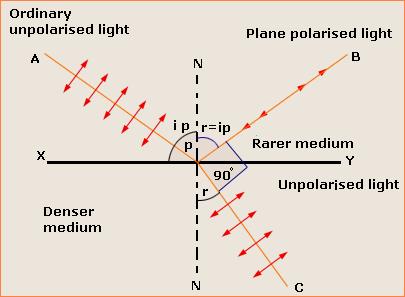Brewster’s Law of Polarization of Light
Brewster’s Law: In 1811 Brewster’s proposed it. When Un-polarized light is incident at the angle called Brewster’s angle or angle of polarization, the light that is reflected from the surface is therefore perfectly polarized.
He was able to prove that the tangent of the angle of polarization is numerically equal to the refractive index of the medium.
That is....
$$\mu = \tan i$$Where µ is the refractive index of the material and i is the polarization angle.
suppose, un-polarized light is incident at an angle equal to the polarizing angle on the glass surface (Denser medium). It is reflected along PB and refracted along PC.

Using Snell's law,
$$n_{1} \sin \theta_{1} = n_{2} \sin \theta_{2}$$one can calculate the incident angle θ1 = θB at which no light is reflected:
$$n_{1} \sin \theta_{B} = n_{2} \sin 90^{\circ} - \theta_{B}$$Solving for θB gives
$$\theta_{B} = \tan^{-1}\left(\frac{n_{t}}{n_{i}}\right)$$